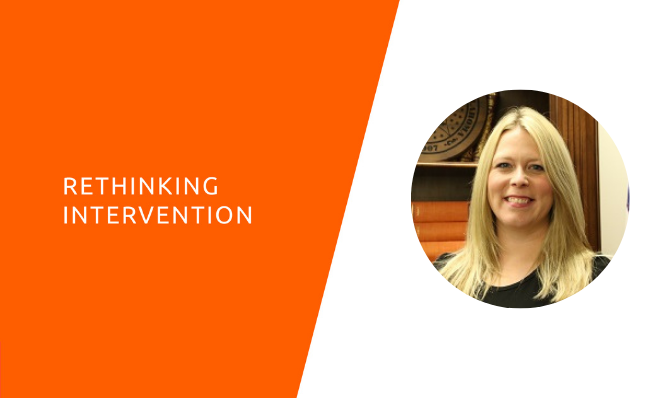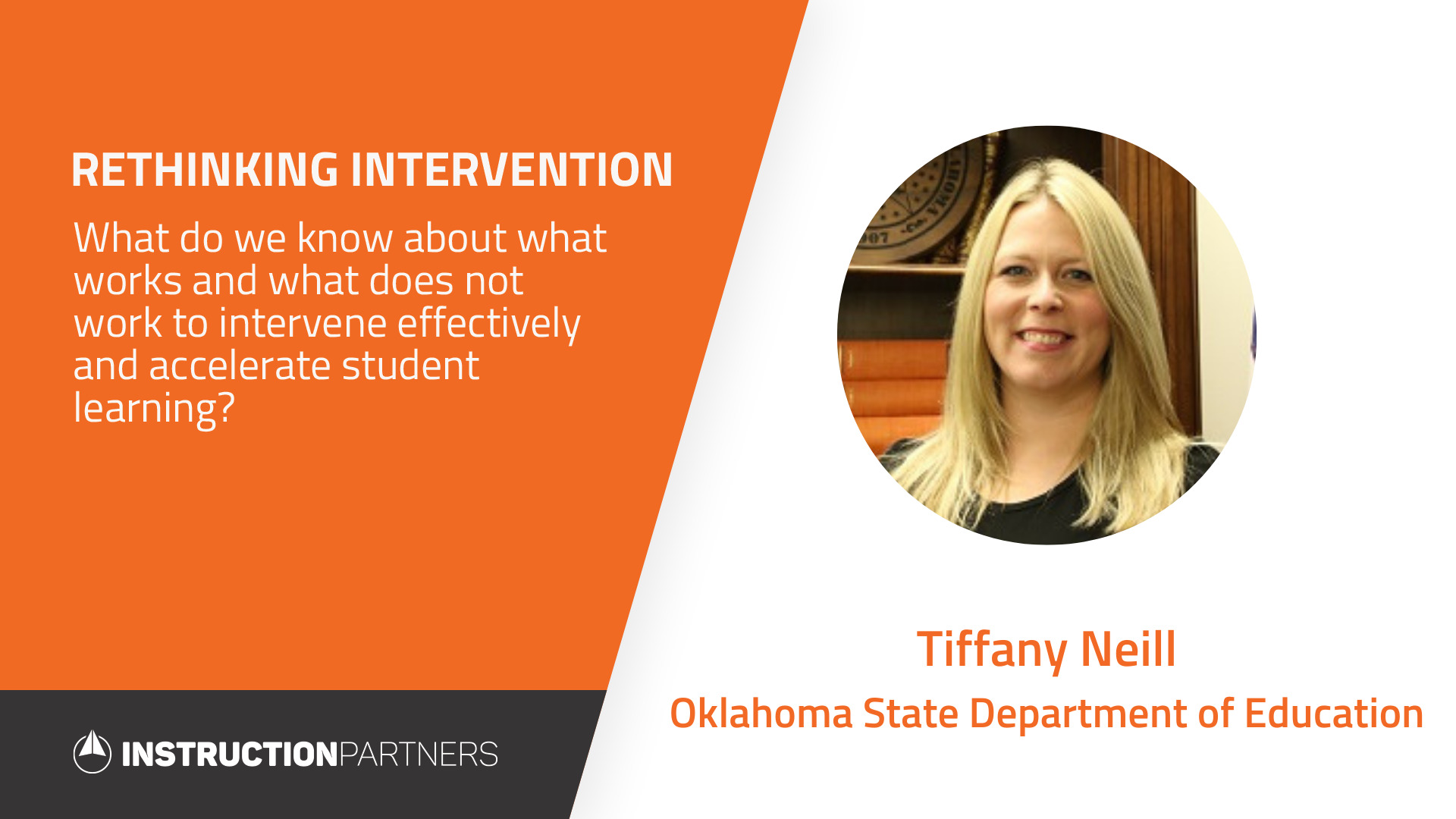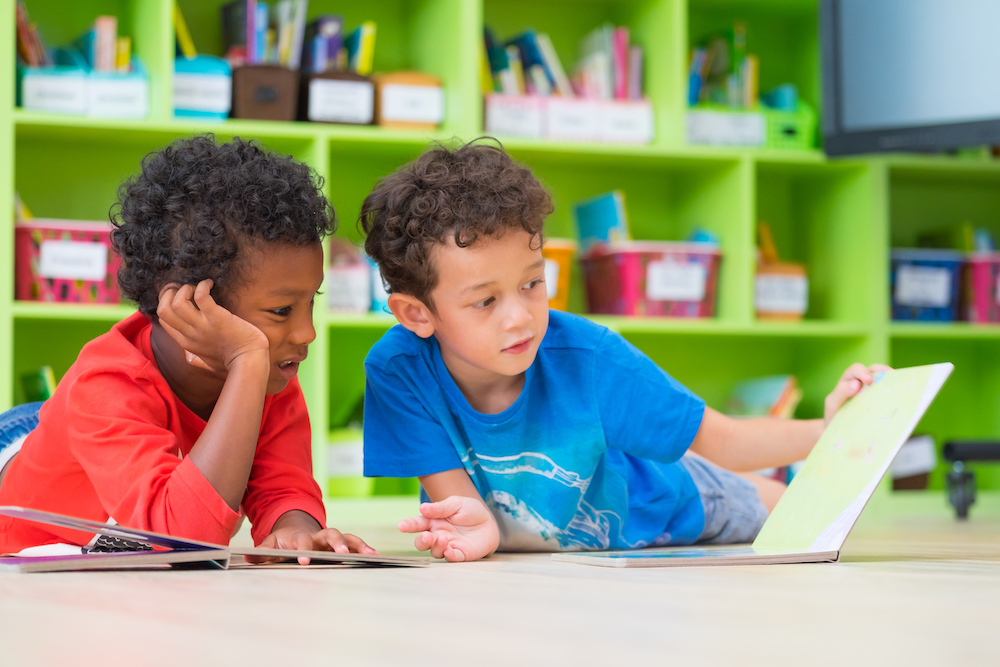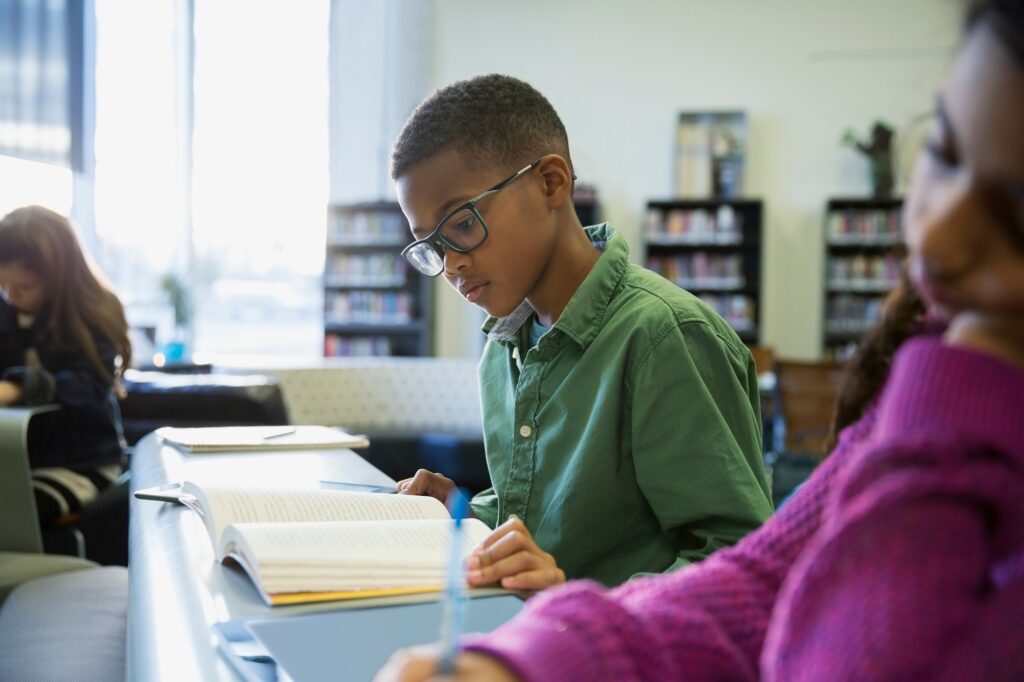
Tiffany Neill, Oklahoma State Department of Education
Tiffany Neill is the Deputy Superintendent of Curriculum and Instruction at the Oklahoma State Department of Education. Before assuming her current role, Tiffany led several efforts to promote Science and STEM education, including the revision of the state science standards, the development of a state strategic plan for STEM, and the development of the Oklahoma STEM Framework.
Tiffany spoke to Emily Freitag about the importance of engaging students in investigating and explaining phenomena in science instruction and providing just-in-time support to accelerate science learning in the wake of disrupted schooling.
Watch the full conversation or read the abridged Q&A below.

EF: Please start with a story from your own journey as a learner, and what that has taught you about learning.
TN: I always had an interest in science. I grew up on a farm part-time and I was always interacting with the natural world and found a lot of curiosities there. I also found that in the school setting, I was good at science when it came to being able to take quality notes and regurgitate that information for assignments. I took a lot of pride in the notes that I took, and that also helped me progress through college to a certain point in my core science courses. But when I got to a certain point in more of the advanced science courses, I recognized that I lacked some of the conceptual understandings of science that would allow me to think critically. For example, in my organic chemistry class, no longer could I get by with just remembering things short-term to regurgitate that information. Somehow I managed to get by even knowing that I still didn’t have a complete understanding of science concepts.
It wasn’t until I began teaching that I started to recognize that there was a certain way that students learn naturally. In the alternative education setting I was in early on, it became apparent to me that if students engaged with something that allowed them to connect to their own worlds, they could draw on background experiences to help them understand the new concepts that I was trying to teach them in science. I say that’s important in my own learning experience because I recognized for myself in college that there was something in the way of deep learning I was missing out on. I started to see naturally with these students that the only productive way of learning was by engaging them in something familiar that they could connect to, and then introducing the new concepts. When I went on to receive my Master’s in Science Education, that’s where I really started to understand the science behind learning. I began to understand why those students and myself learned better and more deeply if the learning was connected to something that was personal. I started to understand that students or myself could connect to background experience, and I could begin to really see where I had gaps in my own understanding. It was a realization that when I had that specific gap, I needed to fill that gap to help move forward in deeper understanding.
My full evolution as a learner came about through the course of the Framework for K–12 Science Education, which is the National Academies document that was published a few years ago that guides many of our science classrooms now. When the framework came out, I had the opportunity to go through a series of professional learning sessions with Brett Moulding, who was on the committee that developed the Framework for K–12 Science Education. He would engage us in investigations of phenomena,those natural events that happen in the world, or set up situations to mirror those events. Often, he would engage us in phenomena that were closely related to earth and space science, which I didn’t have a strong background in. Through those experiences of engaging with a phenomenon and really thinking about, What do I know? And then being provided additional learning opportunities where I could take new pieces of knowledge and add to my current understanding, to further explain that phenomenon, really set me on a path of fully understanding that you really have to be able to investigate a phenomenon and work towards explaining that phenomenon. Deep learning happens when you as a learner can gather more information to refine your thinking, to develop more complex ways of understanding and knowing to explain that phenomenon.
EF: Can you talk more about what we know works in the job of teaching science?
TN: What we have to hold on to is engaging students in investigating and explaining a phenomenon, or investigating and developing design solutions. And that certainly was a shift in my understanding of what quality science learning is. For years, we had all realized that inquiry-based science, or hands-on science, is a great way to for students to learn, but there’s a level of sophistication that develops when you begin to structure your science classroom towards this vision of the Framework for K–12 Science Education or the Next Generation Science Standards. What that shift means is that we’re not setting up opportunities for students to walk through the steps of a laboratory investigation and be able to repeat the steps to get an outcome. Now in that situation, students are doing things with their hands, but what can often be missing from a structure like that is we don’t ask students to think about what’s causing that outcome that they see. Sometimes we’re more focused on the steps that they take to get the outcome or to analyze data from the outcome. But really, it’s that outcome of the investigation or that phenomenon that’s presented that is our starting point for deep learning in science. They’ll then be able to make connections between the learning they have and a new situation, which is what we hope for students.
I’ll give you an example of this with my son. When he was in middle school, I was deep into supporting teachers in our state with this vision for science education of investigating phenomena, and I would try those things out on my son. I noticed one day that we had two different cups sitting in the cup holder in my jeep—he had a plastic cup, and I had a paper cup, and there were different amounts of liquid on the outside of each one of those cups. So I asked him, “What do you notice about these two cups and the liquid on the outside of them?” And he started to share his observations. Almost naturally, he began to ask questions about why there were differences. Why is there liquid on the outside of that cup? Is it seeping outside the cup? Why wouldn’t it be seeping out of the plastic and paper in the same way? That led us down a path together to try to collect some additional information, so we tried out those same cups with different amounts of ice water in them, and we began to look at, When did the liquids show up? Where is the liquid showing up? He began to notice that where the liquid was the colder, the liquid on the outside of the cup began to show up in more droplets.
Now, remember, he still had questions—he couldn’t figure out why the liquid was on the outside of the cup, but I was able to bring some information that helped him understand that the liquid wasn’t seeping out of the cup and that it was the temperature difference compared to the air outside the cup that caused water that was in the atmosphere to change into liquid form. That opened up a whole world of possibilities for him to think about whether that same thing happens in other spaces. If we were in a classroom setting, he would have had that back and forth conversation with his peers—other students his age, with different background experiences to bring into this conversation. He would learn from their background experiences, try to make sense of how this was working, and why it was working. And at the moment that he couldn’t go any further, the teacher brings forward some information that helps him add to and refine his thinking. That’s different than the way I engaged in laboratory experiences as a student in middle school, where I might have gone through steps to get an outcome, and then the teacher might have shared with me some science content related to that. But he gets that opportunity, which means now he’s going to retain that and he can apply it in all kinds of settings.
EF: Can you tell us how you respond to teachers that feel like that approach conflicts with how they learned science themselves, or with the content that they have to cover?
TN: That’s a great question, and it’s one we get often at the state level. If each of the teachers who are listening today were to take a strong look at their state standards, and if they’re in a state that adopted the Next Generation Science Standards, or a state with standards were informed by Next Generation Science Standards, what they might find is that that breadth of content that they may be used to teaching is not there. Or they may wonder, is it hidden in there, and I can’t see all of these terms or concepts that I have been teaching? For example, let’s look at the concepts behind photosynthesis. Previously, when I had taught photosynthesis, there were all these terms that students needed to be familiar with, and I might have taught the steps in the process of photosynthesis to a high degree. But if I take a look at those same standards now around the concepts for photosynthesis, it is about the conceptual understanding of why photosynthesis occurs and how it relates to other things, but it’s not the detailed steps of photosynthesis. So, now I can spend more time engaging students in an investigation that is phenomenon-based to help them understand just the central ideas related to that process, why it occurs, and how it supports plants and connects to animals and all of those sorts of things.
The expectations have been condensed to focus on big ideas in science. Big ideas are not a plethora of terms and steps in a process, but they are those big central ideas that students can walk away with from their PreK–12 experience. I always tell teachers to take a deep look at your standards and understand their intent. Once you understand that you may not have to teach everything that you have been teaching, you then take a look at your curriculum. Many of us in science education have had a textbook as our curriculum. We’ve known for many years that what’s provided in those textbooks is oftentimes way more than what is expected at our grade level, so you have to take a look at that and reduce down to the big ideas.
Now, most states now have the Next Generation Science Standards or are informed by those standards, which means their standards have three dimensions: 1) disciplinary core ideas or science concepts, 2) science and engineering practices, which are the this the practices we want students to engage in like asking questions, planning, and carrying out investigations, arguing from evidence, constructing explanations, and 3) cross-cutting concepts. If my son looked at those two cups and noticed that there was liquid on the outside, but the patterns were different, that difference in the pattern may have triggered him to ask what’s causing that to happen. So, patterns and cause and effect are cross-cutting concepts. We’re trying to get students to develop those thinking skills like scientists and engineers with that third dimension of cross-cutting concepts.
If there are three dimensions of your standards, it means two-thirds of your standards are engaging kids in doing science and engineering and engaging them and thinking like scientists and engineers. So if you are focusing on students investigating a phenomenon, you’re covering two-thirds of your standards. Now it’s just about ensuring they have those big science ideas. Take a real good look at your standards and pare down that curriculum to focus on that. Sometimes that might mean giving up your favorite activity, and I hate to say that. I know I had a couple of investigations I always loved, but when I was teaching high school biology, I recognized that those were not at my grade-level or associated with what I was teaching. Your students’ learning time is extremely valuable, so you have to focus on those most important aspects.
EF: Can you tell us about how we can support unfinished learning in science? What advice do you have for teachers worried about gaps from last spring?
TN: In science, unfinished learning is always where we are at. Keep in mind that, with science, it may be different than other disciplines. So again, let’s look at that example of my son. At the kindergarten grade level, students might be able to make observations about a puddle after a rainy day. They might notice over the course of a couple of days that that rain puddle goes away. If students have those experiences early on, they can use them later to then understand the science ideas that explain why that puddle is going away. When it comes to unfinished learning in science, the idea of acceleration is key. If you have students who didn’t get all of the science ideas this year, then next year, as a science teacher, for every investigation I’m setting up, I’m thinking about what scaffolds are in place to help students bring in whatever they have in the way of their experiences, and then I’m going to work to help them build on those ideas. It doesn’t necessarily mean that I need to think about what needs to be retaught that they may have missed out on. What it means is I need to have some really good touchpoints for a formative assessment to understand students’ current understanding and ability. And then ask, What am I going to need to intentionally bring in to help them build upon those understandings?
EF: So you’re describing “just-in-time,” not “just-in-case” interventions?
TN: Yes. Again, you have to be really intentional about having those touchpoints to see where your students are in their understanding. Teaching science with students engaged in an investigation of a phenomenon lends itself nicely to the ideas of acceleration and not reteaching. More traditional ways of teaching science would require remediation because you’re trying to have students collect more and more factual information. That’s not what we’re talking about with science instruction today. It’s about big ideas and building the level of sophistication of understanding of those big ideas so that you can explain a phenomenon or design a solution. And if that’s the goal, then you really can layer on those understandings in that just-in-time setting.
EF: What else do you hope we don’t do in response to this disruption in learning?
TN: One is spending a lot of time reteaching facts that don’t relate to the big ideas of science. The other is that there may be a tendency to reduce time on science or eliminate science for some students, if it’s deemed that those students need support in other disciplinary areas, like literacy or mathematics. When we think about the number of careers that students will go into that connect to science or engineering, it’s just incomprehensible how many careers are available to students in those spaces. We know that students from a young age start to determine whether or not they’re good at science, so if they miss these rich experiences we’ve been talking about, or if they’re reduced to reading about science as their only way of understanding it, then we could miss out on building interest and curiosity in the field of science and engineering. If students don’t have access to those experiences in elementary because we may be trying to compensate for other areas, we wouldn’t see the outcome of that for many years. That is a real concern for us when we think about our workforce development. It’s not just about what our high school students are doing to be prepared for college, it’s about what we’re seeing at these early grade levels right now that could have an impact far down the line.
EF: Don’t we already see that happening? We already see that prioritization often minimizes time spent on science.
TN: When we think about a student like my son who takes a look at those two cups and starts having curiosity, the first thing I wanted to do in the classroom is to ask him to share his thoughts. There are a lot of the speaking and listening skills that we want to gain through English language arts or literacy. In addition to that, I would ask him to draw out or write down his initial explanation for why that might be happening. The whole goal is that he’s getting his thoughts from his brain on paper, and he’s able to translate that. That requires strong literacy skills. As far as the reading and reading comprehension skills go, at that moment when my son needed more information to build on his understanding, I might present him with a small bit of text and ask him to read it using close-reading strategies—highlight anything in that text that might help you better explain this phenomenon, circle anything you don’t understand, put a star by anything you find interesting. When he reads that text, I know the level of literacy that he’s gaining, because now I’m going to ask him to take what he read in that text, and talk about the things he didn’t quite understand. We’re developing vocabulary when we do that. Now imagine how deeply students understand the text presented to them because they’re incorporating it to make sense of something, not just answer a question. When we talk about science being taught this way, everything has a literacy connection. It’s not just about integration, it’s naturally there if we leverage the opportunity to engage students in learning this way. It’s deep literacy skills that they’re gaining in the context of science and engineering, which we hope they then carry on throughout their school years and into college and their careers.


